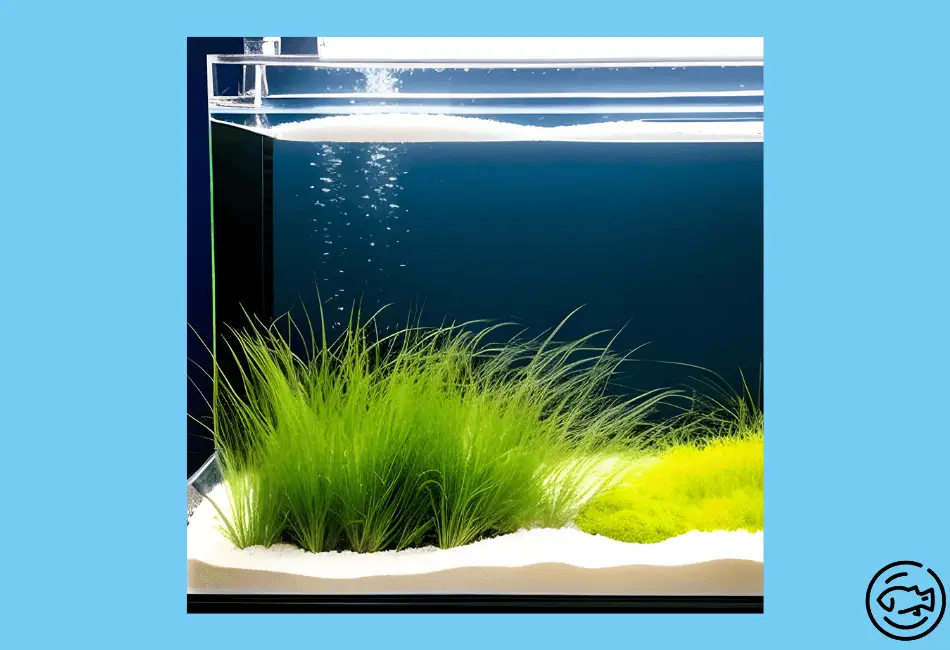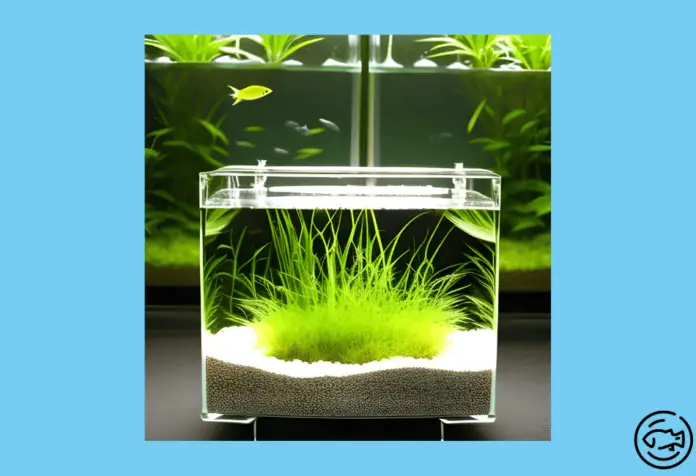Aquarium plants exhibit diverse shapes and sizes, making it challenging to determine the right one for your needs. If you’re seeking a carpet species, several options are suitable for home aquariums.
Dwarf hairgrass is one such option, and this species forms a meadow-like expanse across the tank’s bottom with its grass-like appearance. Moreover, it oxygenates the water, eliminates pollutants, and is a haven for bottom-dwelling fish.
Even those with limited experience in aquatic plants should find this species manageable, as it is resilient and adaptable.
This article covers everything you need about dwarf hairgrass, covering aspects such as appearance, tank requirements, tank mates, and seed propagation.
Overview
Dwarf hairgrass, belonging to the Cyperaceae family, consists of two species: Eleocharis parvula and Eleocharis acicularis. These freshwater plants are easy to care for and exhibit a fast growth rate, reaching a maximum size of six inches.
They thrive in a minimum 10-gallon tank with water conditions ranging from 50-85°F, a pH of 6.5-7.5, and a KH of 2-10. Moderate lighting and carpet placement are ideal for these plants, which propagate through runners.
These species have a widespread global presence in North America, Europe, Asia, and South America.
They are commonly found in shallow freshwater environments with abundant access to light. Dwarf hairgrass often serves as a carpet, blanketing the tank’s bottom with a lush green layer.
As a fast-growing plant, even a small amount quickly multiplies to create this effect.
The carpet offers shelter to bottom-dwelling fish, such as pictus catfish, while also oxygenating the tank and purifying the water.
Dwarf hairgrass is a popular choice in the fishkeeping industry due to its low-maintenance nature.
Requiring only light, nutrients, and CO2, this plant is easy to maintain and well-suited for beginners who may need more time to devote to its care.
Appearance

Dwarf hairgrass is an aquatic plant with vivid green, hair-like strands that can reach heights of 4-6 inches. Its compact size makes it appropriate for smaller aquariums, and its typical fast growth and low maintenance appeal to both experienced and novice aquarists.
Dwarf hairgrass is classified into two species—Eleocharis parvula and Eleocharis acicularis. They are similar, though Eleocharis acicularis has a slightly more curled appearance and can grow taller. Both varieties are relatively easy to maintain and look striking under bright aquarium lighting.
In the wild, dwarf hairgrass can be found across the globe. It thrives in shallow freshwater environments with an abundant light source, such as along riverbanks.
Dwarf Hairgrass Tank Requirements
Although dwarf hairgrass can be found worldwide, it typically thrives in similar environments wherever it grows.
The most crucial factor is shallow tropical freshwater with ample access to light, and they are commonly found in sandy or muddy areas along rivers or lakes.
Recreating these habitats at home is relatively easy, and as a robust plant, it can flourish in various setups.
The first aspect to consider is the size of your tank, and as a small plant at the bottom of the tank, hairgrass can be accommodated in tanks as small as 10 gallons.
The aquarium should have a substrate layer not exceeding 1.5 inches in thickness. Sands are ideal because the refined grains allow the roots to penetrate easily.
Water temperature can fall within a wide range, from 50-83°F. This plant’s ability to survive in cool waters is one reason for its extensive distribution.
The pH should remain reasonably neutral (6.5-7.5), so steer clear of highly acidic or alkaline waters. Soft to moderately hard water (2-10 KH) is preferred.
Aquarium lighting is vital for photosynthesis and plant growth. Most commercially available lights will suffice.
How To Plant Dwarf Hairgrass
It’s essential to plant your dwarf hairgrass on a soft substrate to prevent root damage from the grains. Once the substrate is prepared, you need to determine the placement of your plants.
You can situate this plant across the bottom of the tank as a carpet species. Some individuals opt to cover the entire tank bottom with this plant and trim the plants at the front shorter than those at the back.
The ideal planting location should have ample light for photosynthesis.
Unlike some plants, dwarf hairgrass cannot photosynthesize in shaded areas. When planting, ensure the roots are fully buried in the substrate while keeping all the strands above the substrate.
Dwarf Hairgrass Seed Propagation
Dwarf hairgrass propagates rapidly, but controlling the propagation process is more challenging than other species, such as water wisteria.
For many aquatic plants, propagation can be accelerated by planting cuttings elsewhere.
However, this method isn’t adequate for dwarf hairgrass since the cuttings won’t develop their roots.
As this plant matures, runners form and extend from the root area, eventually evolving into independent plants, growing from the seeds upward. It’s difficult to manipulate this process since you can’t create your roots.
Fortunately, this usually isn’t an issue because dwarf hairgrass grows swiftly. This rapid growth means that runners are generated frequently, and the carpet quickly expands across the entire tank.
If propagation occurs more slowly than you’d like, you can expedite the process by ensuring the plant has everything it needs for growth.
Make sure the aquarium has enough nutrients and CO2 and that there’s ample access to light. Increasing the water temperature while remaining within the acceptable range should also accelerate growth rates.
Tank Mates
Compatibility issues are minimal with this plant, as it can coexist with most other plants and tropical fish.
If you have other plants in your tank, be cautious of the dwarf hairgrass becoming too dense. An overly thick carpet forces plant to compete for resources, and dwarf hairgrass is particularly adept at this, potentially causing other plants to perish.
Fish often nibbles plants with large leaves, but since this plant has elongated strands, it’s less likely to be consumed, although it may still occur occasionally.
You have numerous options when considering fish for the tank. Small, peaceful fish are ideal as they’re less likely to cause harm. Danios, Guppies, Mollies, and Tetras are a few excellent examples. Other similar fish should also be compatible.
As this plant creates a carpet, bottom-dwelling fish will benefit the most from its presence.
Bumblebee Catfish, Clown Loaches, Corydoras Catfish, Khuli Loaches, Yoyo Loaches, and Zebra Loaches will appreciate the additional shelter.
Avoid large, boisterous fish, such as Oscars, notorious for uprooting plants in search of food. Snails can easily damage plants, including your hairgrass. However, certain species (like assassin snails) don’t consume plants as much, offering options if you’re determined to have snails.
Shrimp is another popular invertebrate for aquariums and should have a minimal impact on your plants as long as they’re healthy.
Dwarf Hairgrass In Sand
Dwarf Hairgrass can grow without soil, thriving just as well on sandy substrates or even gravel.
When purchasing Dwarf Hairgrass for your aquarium, it’s crucial to plant the roots into the substrate while keeping the blades above.
The blades must remain above the substrate for photosynthesis.
Failure to cultivate Dwarf Hairgrass correctly may result in the plant not flourishing, spreading, or even dying. Although it may seem laborious, separating the individual clumps of Dwarf Hairgrass before planting can help the plant carpet your tank more rapidly.
Growing it together in a single cluster will significantly delay achieving the desired carpet effect. Trimming your Dwarf Hairgrass a few days after planting can also stimulate growth.
Dwarf Hairgrass Light Requirements
In their natural habitat, Dwarf Hairgrass flourishes near the water’s edge or in shallow areas with abundant sunlight for photosynthesis.
Consequently, these plants require a substantial amount of light in an aquarium environment.
While most typical aquarium lighting suffices for Dwarf Hairgrass, ensure that the illumination isn’t obstructed or muted by floating plants or ornaments.
Dwarf Hairgrass In Gravel
Dwarf Hairgrass is a resilient plant that can grow in rougher substrates such as gravel; however, there are a few aspects to consider before selecting gravel as your substrate for Dwarf Hairgrass.
Using gravel as a substrate can hinder the growth of runners and offshoots, preventing the plant from spreading effortlessly throughout your tank.
As a result, your Dwarf Hairgrass may grow in patchy clusters, which lack the lush carpet appearance that a soft, fine substrate can provide.
Moreover, gravel can make inserting root tabs into the substrate more challenging.
Creating A Carpet Of Dwarf Hairgrass
Dwarf Hairgrass is a striking feature in your aquarium while offering a cozy environment for fish. It contributes to oxygenating the water and removing contaminants.
Its aesthetic appeal makes it a popular choice for aquariums. A flourishing carpet of Dwarf Hairgrass enhances any aquatic setting, and you can cultivate one yourself.
When given the right conditions, Dwarf Hairgrass propagates on its own, swiftly covering your aquarium’s bottom with a lush, grass-like carpet. Indeed, you should fine-tune your water parameters to achieve the perfect balance if you observe rapid growth and spreading.
When acquiring Dwarf Hairgrass, separating the clumps during planting is crucial. Space these smaller clumps evenly in the substrate, allowing each plant to form its runner from the roots.
Selecting an appropriate substrate is vital for a complete carpet of Dwarf Hairgrass, as some substrates can impede root runners and decelerate growth.
Once sources develop runners, offshoots will emerge and create new blades. Clippings from Dwarf Hairgrass won’t grow new roots, so you cannot achieve the desired full carpet appearance in your aquarium using cuttings.
With enough initial planting, Dwarf Hairgrass can quickly create a lush carpet in your aquarium. This not only benefits your fish but also adds to the visual appeal of your aquatic environment.
Conclusion
Dwarf Hairgrass is a manageable plant for most individuals due to its hardiness and minimal maintenance, only requiring occasional trimming.
It thrives in various aquarium sizes and adapts to a wide array of environments, making it suitable for diverse setups. This plant is an excellent option for hobbyists at any skill level.
As a carpet species, it brings vibrancy to the tank’s bottom while offering a haven for stressed fish. Introducing Dwarf Hairgrass to your aquarium enhances its overall health by oxygenating the water and removing pollutants before they reach dangerous levels.
Its popularity as a carpet plant is easy to understand, given its many benefits. Do you consider Dwarf Hairgrass your top choice for carpet species?
Please communicate your experiences with us in the comments section below!



